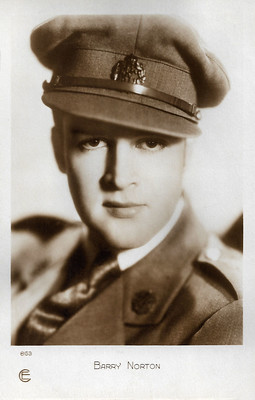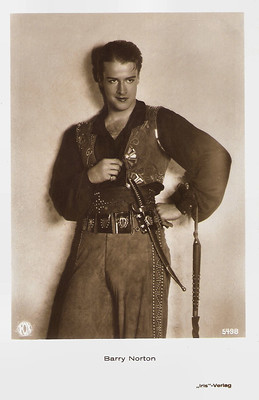
French postcard by Europe, no. 4932. Photo: Fox Films / Astra Cinégrafica.

Italian postcard by G.B. Falci Editore, Milano, no. 711 Photo: Charles Munn Autrey / Fox. Charles Morton, Janet Gaynor, Nancy Drexel, and Barry Norton in 4 Devils (Friedrich Wilhelm Murnau, 1928). 4 Devils is one of the most famous 'lost' films.

German postcard by Ross Verlag, no. 1854/1, 1927-1928. Photo: Fox.

German postcard by Ross Verlag, no. 4394/1, 1929-1930. Photo: Max Munn Autrey / Fox.

German postcard by Ross Verlag, no. 4856/1, 1929-1930. Photo: Fox.
There's a boy that is a 'natural'
Barry Norton was born Alfredo Carlos Birabén in 1905 in Buenos Aires, Argentina. He was the scion of a wealthy Argentine family. In 1923, Norton emigrated to the United States as a second cabin class passenger under the name of Carlos Manuel A. Biraben on the S/S Vestris, which had sailed from Buenos Aires, on 12 March, and arrived at the Port of New York on 1 April 1923.
Years later, he became a naturalised United States citizen. He was a talented ballroom dancer. After stops in New York City and Chicago, he finally came to Hollywood, where he first worked as an office assistant for Douglas Fairbanks.
On-screen, Norton first appeared as an extra in Fairbanks' silent action-adventure film The Black Pirate (Albert Parker, 1926). The boyish-looking actor signed a contract with the Fox Film Corporation and was soon cast in The Lily (Victor Schertzinger, 1926) with Belle Bennett.
His big break came when he was given the role of Pvt. "Mother's Boy" Lewisohn in the silent comedy-drama war film What Price Glory? (Raoul Walsh, 1926) which turned out to be a huge commercial success. Another success was Sunrise: A Song of Two Humans (F.W. Murnau, 1927) starring George O'Brien, Janet Gaynor, and Margaret Livingston. Norton only appeared in a bit role but he landed a substantial role in Friedrich Wilhelm Murnau's 4 Devils (F.W. Murnau, 1928) opposite Janet Gaynor and Charles Morton.
Norton then landed a leading role as Emil Jannings' son in the drama Sins of the Fathers (Ludwig Berger, 1928). He also played a leading role opposite Gary Cooper and Fay Wray in Legion of the Condemned (William Wellman, 1928) which was also very successful. His acting was well-received by audiences and critics at the time, and, during the silent era, he avoided being typecast as a Latin lover. One theatre owner in Golden City, Montana, said, "[Norton] has as yet to show me a bad performance. There's a boy that is a 'natural'."

Italian postcard by G.B. Falci Editore, Milano, no. 708. Photo: Max Munn Autrey / Fox. Janet Gaynor, Nancy Drexel, Barry Norton and Charles Morton in 4 Devils (Friedrich Wilhelm Murnau, 1928). 4 Devils is one of the most famous 'lost' films.

Dutch postcard. Photo: Fox. Barry Norton, Janet Gaynor and Nancy Drexel in 4 Devils (F.W. Murnau, 1928).

German postcard by Ross Verlag, no. 5004/1, 1930-1931. Photo: Fox. Imprint on the back of Ballerini & Fratini, Firenze.

German postcard by Ross Verlag, no. 5468/1, 1930-1931. Photo: Fox.

German postcard by Ross Verlag, no. 5737/1, 1930-1931. Photo: Paramount Pictures.
Usually playing sophisticated Europeans
In the early 1930s, Barry Norton could still get interesting roles in major films. He made a brief but incisive appearance in Josef von Sternberg's Dishonoured (1931). At the end of the film, he is seen as a young lieutenant who refuses to carry out the execution of a spy played by Marlene Dietrich.
The Hollywood studios started producing alternate-language versions of their prestige productions, and he became one of the dozens of Latino actors needed. In Drácula (George Melford, 1930) he played the vampire's antagonist, Juan Harker. It was simultaneously shot with Bela Lugosi's classic Dracula (Tod Browning, 1931) in the late hours and using the same sets. Norton also appeared in Spanish-language versions of Paramount on Parade (Edmund Goulding, a.o., 1930), The Benson Murder Case (Frank Tuttle, 1930), and The Criminal Code (Howard Hawks, 1931).
In a few cases, he appeared in both versions of a film. Examples include Storm Over the Andes/Alas sobre El Chaco (Christy Cabanne, 1935), Devil Monster/El diablo del Mar (S. Edwin Graham, 1936), and Captain Calamity/El capitan Tormenta (John Reinhardt, 1936), the latter film reuniting him with Lupita Tovar, his romantic interest from Dracula.
In addition to roles in Spanish-territory films, he had roles in numerous major films, usually playing sophisticated Europeans. With the decline in Spanish-language film production in Los Angeles, Norton's opportunities for leading roles became less and less frequent. Though he had a pleasing voice, his Argentine accent seemed incongruous with his appearance. According to some sources, he never mastered English very well. In 1933, he secured what would be his last important role, playing Jean Parker's Spanish fiancé in Frank Capra's Lady for a Day (1933). Although he would continue to work for another 15 years, Norton's last credited screen role would be in the comedy Should Husbands Work? (Gus Meins, 1939) starring James Gleason. For the rest of his career, Norton continued to reside in Los Angeles and obtain small roles in films.
Norton was married to Josephine Byers, a woman from California by whom he had a daughter, Sharon, and two grandchildren. In her autobiography 'Being and Becoming', actress Myrna Loy wrote that she briefly dated Norton. Other sources link him romantically with Dorothy Dare and Alice Terry. In the latter's case, they appear to have been friends rather than lovers. Barry Norton died of a heart attack in 1956 in Los Angeles, Hollywood, California. He was 51 years old. He died penniless and his old Hollywood friends – among them Antonio Moreno, Gilbert Roland, Gertrude Astor, Philo McCullough and Charles Morton – took up a collection to pay for his cremation, which required the permission of his brother in Buenos Aires.

French postcard by Edition Ross, no. E 4856-1. Photo: Fox.

French postcard by Cinémagazine-Edition, no. 863.

Italian postcard, no. 632. Photo: Autrey / Fox Film Corp., Rome.

British postcard in the Picturegoer series, London, no. 423.

British postcard in the Picturegoer Series, London, no. 423a. Sent by mail in the Netherlands in 1931.

Austrian postcard by Iris Verlag, no. 5427. Photo: Fox.

Austrian postcard by Iris Verlag, no. 5498. Photo: Fox.

Polish postcard by Polonia, Krakow, no. 805. Photo: Fox Film.
Sources: Wikipedia and IMDb.
No comments:
Post a Comment